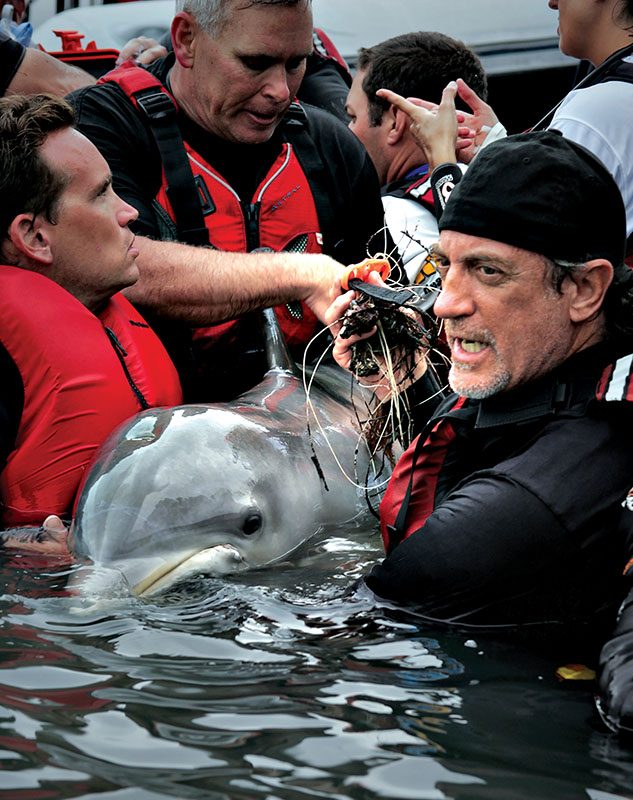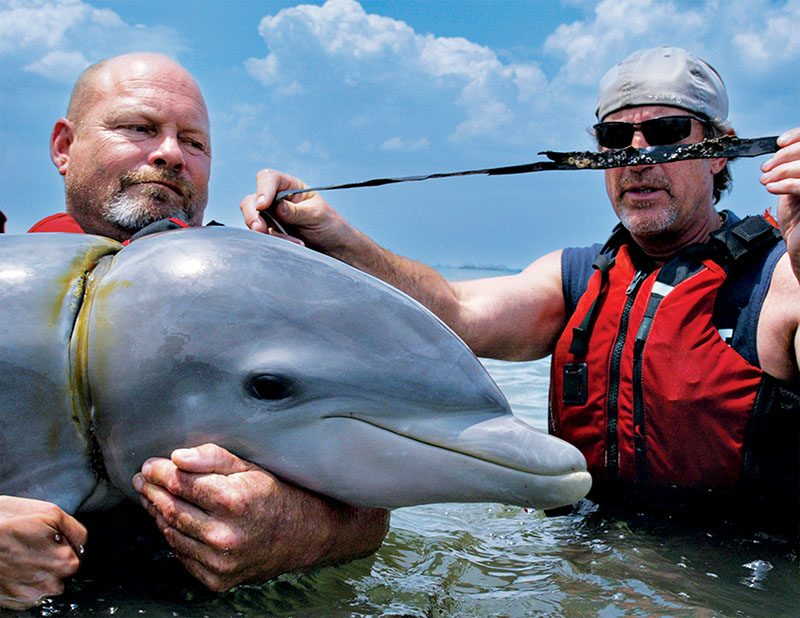Une menace mondiale croissante pour la faune et la flore marines
We’ve all seen tragic images of suffering marine animals entangled in monofilament line or other marine debris. Such images highlight the need to act, but what can we ocean advocates do to limit such harmful impacts on marine wildlife? Who responds when someone calls for help?
Working on the front lines of marine mammal rescues, I’ve been privileged to work alongside some of the best people in the most challenging circumstances, including high-risk interventions, where we safely capture at-risk marine mammals to remove entanglements and evaluate their health. It’s usually fishing gear and monofilament line, but we’ve also encountered dolphins entangled in fan belts, inner tubes, a Frisbee disc, and even a pair of underwear. We once left the safety of the cage while filming off Guadalupe Island to disentangle an 11-foot (3,3 meters) great white shark that had a plastic box band stuck around its neck.
Les enchevêtrements d'animaux marins se produisent lorsque des engins de pêche ou des débris marins s'enroulent autour d'un animal, l'alourdissant ou limitant ses mouvements. L'enchevêtrement des engins de pêche est un problème mondial qui touche plus de 260 espèces aquatiques, dont des mammifères marins, des tortues de mer et des oiseaux de mer.
Whether you’re a diver or a dolphin, a shark or a seabird, any entanglement can pose serious risks and become life-threatening. Our dive training helps us remain calm and signal for help, but animals often face a slow and painful death by drowning, starvation, or systemic infection.
The case of Snow Cone, a North Atlantic right whale, and her calf is a poignant example of entanglement’s long-term impacts. When she was first spotted off the Massachusetts coast in March 2021, Snow Cone already needed help. A team of trained experts were unable to remove all the gear, some of which was deeply embedded in her jaw. In December 2021, while still partially entangled, Snow Cone gave birth. Fewer than 100 breeding females remain, so this birth was cause for celebration and increased the need to quickly disentangle her.

Plusieurs tentatives de sauvetage courageuses pour démêler Snow Cone se sont avérées vaines en raison des conditions dangereuses dues au mauvais temps. Les dernières images de cette mère léviathan et de son petit encore dépendant datent du 22 septembre 2022 et montrent un Snow Cone émacié, presque immobile à la surface et couvert de poux de mer. Le baleineau se frotte doucement à sa mère, qui est incapable de répondre ou d'allaiter son bébé. Selon la National Oceanic and Atmospheric Administration (NOAA) Fisheries, il reste moins de 350 de ces gentils géants.
The long-term effects of entanglement include deteriorating health, fatigue, decreased reproductive ability, and starvation. It can also result in deformity or amputation. One well-known entanglement story involves a dolphin named Winter, who became entangled in crab fishing pot gear in Indian River Lagoon, Florida. Winter suffered ischemic necrosis and lost her tail fluke over several months during rehabilitative care. Two films about her rescue and prosthetic tail helped increase public awareness and brought much-needed rescue resources to Florida’s Gulf Coast region and the entire state.
The International Whaling Commission estimates that globally 300,000 whales, dolphins, and porpoises die from entanglements each year, and NOAA’s National Marine Fisheries Service has identified entanglement as the leading cause of death for large whales in the U.S. The effects of fishing gear interactions are among the most pressing issues that U.S. marine mammal management agencies are currently addressing.

How do we solve the problem of entanglements, and what do we do when we witness a marine animal in distress? Public awareness is crucial, especially within the diving, boating, and ocean conservation communities. Knowing who to call is a significant part of that awareness. First, don’t take risks, and don’t push a stranded animal off the beach. Instead, immediately contact your local stranding network organization. A list of network resources is available at fisheries.noaa.gov/report. You can also report injured marine wildlife by using the Whale Alert app (iOS and Android) or NOAA’s Dolphin and Whale 911 app (iOS), or by calling NOAA’s National Enforcement Hotline at 800-853-1864.
Les stratégies de gestion potentielles comprennent l'interdiction d'activités de pêche spécifiques ou l'imposition de restrictions saisonnières. Des technologies telles que les pièges sans fil ou les dispositifs de dissuasion acoustiques pourraient toutefois permettre d'atténuer l'impact des enchevêtrements sur la faune marine. En fin de compte, c'est à nous de jouer. Les campagnes de sensibilisation du public destinées à tous les usagers de la mer peuvent se concentrer sur les actions visant à prévenir l'enchevêtrement, telles que l'utilisation de pratiques de pêche plus sûres et le soutien de programmes de conservation des océans tels que Dive Against Debris (Plongée contre les débris) pour signaler, réduire et retirer les débris marins.
As a stranding coordinator and rehabilitation specialist for more than four decades, I’ve seen my share of entangled animals. As with any emergency, the sooner someone notifies us of an animal in distress, the better its chances of survival. Responding to entangled animals, especially enormous whales, is inherently dangerous. While many people empathize with the animals and want to help, untrained members of the public should never attempt to free entangled dolphins, whales, or manatees. The best way to help is by monitoring the animal and reporting the situation using the previously mentioned resources or to a local state wildlife agency.
Pour plus d'informations sur les enchevêtrements de mammifères marins, veuillez consulter le site suivant fisheries.noaa.gov/insight/entanglement-marine-life-risks-and-response. Pour des conseils sur la façon dont les plongeurs peuvent éviter de s'empêtrer, voir scubadiving.com/9-tips-avoiding-underwater-entanglements.
© Alert Diver - Q1 2023